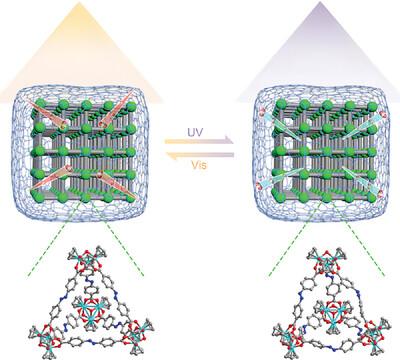当前位置:
X-MOL 学术
›
Adv. Funct. Mater.
›
论文详情
Our official English website, www.x-mol.net, welcomes your feedback! (Note: you will need to create a separate account there.)
Improving Stability, Crystallinity, and Photo‐Responsiveness of Supramolecular Frameworks by Surface Polymerization
Advanced Functional Materials ( IF 18.5 ) Pub Date : 2024-07-01 , DOI: 10.1002/adfm.202404869 Tao Yang 1 , Xue‐Mei Li 1 , Yang Liu 1 , Chao Wei 1 , Chen Gu 1 , Mingrui Zuo 2 , Tianyu Guo 2 , Guoliang Liu 1 , Lifeng Ding 2 , Xiao‐Qin Liu 1 , Lin‐Bing Sun 1
Advanced Functional Materials ( IF 18.5 ) Pub Date : 2024-07-01 , DOI: 10.1002/adfm.202404869 Tao Yang 1 , Xue‐Mei Li 1 , Yang Liu 1 , Chao Wei 1 , Chen Gu 1 , Mingrui Zuo 2 , Tianyu Guo 2 , Guoliang Liu 1 , Lifeng Ding 2 , Xiao‐Qin Liu 1 , Lin‐Bing Sun 1
Affiliation

|
Metal–organic cage‐based photo‐responsive supramolecular frameworks (PSMFs) with permanent porosity have gained attention for their modular properties, controllable functionality, and light‐induced reversible responsiveness. However, their high porosity and photo‐responsive efficiency are often compromised due to poor structural stability upon solvent removal, limiting their potential applications. Here, a solution to overcome this challenge by employing a surface polymerization strategy using isophorone diisocyanate (IDI) to stabilize PSMF (PCC‐20t) is presented. This approach results in the composite of PCC‐20t@PolyIDI, which preserves crystallinity and permanent high‐porosity while avoiding structural collapse commonly observed in highly porous supramolecular frameworks. Moreover, compared to activated PCC‐20t, PCC‐20t@PolyIDI exhibits an 18.6‐fold increase in specific surface area. Remarkably, the structural variability of PCC‐20t@PolyIDI can be observed in the photo‐regulation behavior of CO2 capacity under the irradiation of vis‐ and UV‐light, showing a 27.9% change in adsorption amount for CO2 which is significantly higher than that of the activated PCC‐20t with 7.0% for CO2 . Grand Canonical Monte Carlo simulations demonstrate the light‐regulated adsorption performance is attributed to the configuration transformation of azobenzene from trans ‐ to buckling state. The findings may pave the way for stabilizing high‐porosity materials to simultaneously meet demands for high‐porosity and photo‐responsive efficiency.
中文翻译:

通过表面聚合提高超分子框架的稳定性、结晶度和光响应性
具有永久孔隙的金属有机笼基光响应超分子框架(PSMF)因其模块化特性、可控功能和光诱导可逆响应性而受到关注。然而,由于溶剂去除后结构稳定性差,它们的高孔隙率和光响应效率往往受到损害,限制了它们的潜在应用。本文提出了一种克服这一挑战的解决方案,即采用异佛尔酮二异氰酸酯 (IDI) 的表面聚合策略来稳定 PSMF (PCC-20t)。这种方法产生了 PCC-20t@PolyIDI 复合材料,它保留了结晶度和永久的高孔隙率,同时避免了在高孔隙超分子框架中常见的结构塌陷。此外,与活化的 PCC-20t 相比,PCC-20t@PolyIDI 的比表面积增加了 18.6 倍。值得注意的是,PCC-20t@PolyIDI在可见光和紫外光照射下的CO2容量光调节行为中可以观察到结构变异,显示出CO2吸附量变化了27.9%,明显高于活化的 PCC-20t 的 CO2 浓度为 7.0%。大正则蒙特卡罗模拟表明,光调节吸附性能归因于偶氮苯从反式态到屈曲态的构型转变。这些发现可能为稳定高孔隙率材料以同时满足高孔隙率和光响应效率的需求铺平道路。
更新日期:2024-07-01
中文翻译:

通过表面聚合提高超分子框架的稳定性、结晶度和光响应性
具有永久孔隙的金属有机笼基光响应超分子框架(PSMF)因其模块化特性、可控功能和光诱导可逆响应性而受到关注。然而,由于溶剂去除后结构稳定性差,它们的高孔隙率和光响应效率往往受到损害,限制了它们的潜在应用。本文提出了一种克服这一挑战的解决方案,即采用异佛尔酮二异氰酸酯 (IDI) 的表面聚合策略来稳定 PSMF (PCC-20t)。这种方法产生了 PCC-20t@PolyIDI 复合材料,它保留了结晶度和永久的高孔隙率,同时避免了在高孔隙超分子框架中常见的结构塌陷。此外,与活化的 PCC-20t 相比,PCC-20t@PolyIDI 的比表面积增加了 18.6 倍。值得注意的是,PCC-20t@PolyIDI在可见光和紫外光照射下的CO2容量光调节行为中可以观察到结构变异,显示出CO2吸附量变化了27.9%,明显高于活化的 PCC-20t 的 CO2 浓度为 7.0%。大正则蒙特卡罗模拟表明,光调节吸附性能归因于偶氮苯从反式态到屈曲态的构型转变。这些发现可能为稳定高孔隙率材料以同时满足高孔隙率和光响应效率的需求铺平道路。











































 京公网安备 11010802027423号
京公网安备 11010802027423号